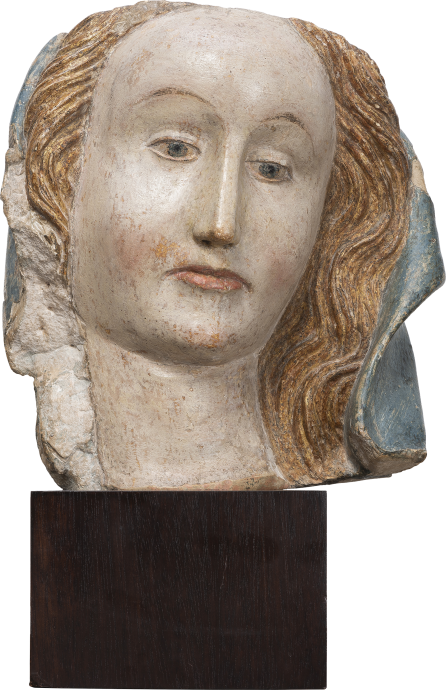


Head of the Virgin Mary
, c. 1400-1450

Head of the Virgin Mary
Description
This limestone head of the Virgin Mary is sculpted in the “Beautiful Style” (Schöner Stil), among the most celebrated forms of the International Gothic. It was originally from a figure of the Virgin Mary, either a standing statue of the Virgin and Child or an Annunciation group. The face is carved with elongated proportions evocative of the Beautiful Style, including a rounded forehead, protruding chin, and long neck. Other features are painted or heightened in wonderfully preserved polychrome, including golden hair, thin eyebrows, blushed cheeks, red lips, and blue mantle. Wavy locks of hair frame the Virgin’s face along with folds of fabric. A flat plane across the top of the head indicates where a crown would have originally rested. Draped folds continue around the sides but not entirely around the head, with some rough-hewn surfaces visible at the back, suggesting the figure was originally situated in a niche or altarpiece.
This sculpture belongs to the well-known type of the “Beautiful Madonna” (Schöne Madonna) that emerged in the decades before 1400 in Prague and Bohemia and quickly spread to areas in Bavaria and Austria. Famously studied by Wilhelm Pinder and Karl Clasen, Beautiful Madonnas are defined by their slender facial features and serpentine poses, with one leg supporting the infant Christ Child. Based on stylistic details, this head of the Virgin can be placed in the Bohemian group or perhaps an Austrian variant. The proportions of the face and the polychromy are comparable to the Hallstatt Madonna (fig. 1). Like other Austrian Virgin and Child statues, the Hallstatt Madonna was sculpted in the style of the Krumauer (or Krumlov) Madonna of c. 1390 (Vienna, Kunsthistorisches Museum), sculpted in Bohemia (fig. 2). The present head also preserves its white, blue, and gold polychrome, the canonical colors that distinguish representations of the Virgin Mary.
Original polychromy is in remarkable condition. The head sustains losses on the left side, revealing white limestone, with less substantial losses around the sides and back, and is mounted on a square wood base.
Literature
Unpublished. For comparisons, see:
Clasen, K. Der Meister der Schönen Madonnen: Herkunft, Entfaltung und Umkreis, Berlin; New York, 1974.
Schmidt, G. Gotische Bildwerke und Ihre Meister, Vienna; Cologne; Weimar, 1992.
Söding, U. Schöne Madonnen: Standbilder und Sitzfiguren, Munich, 2008.